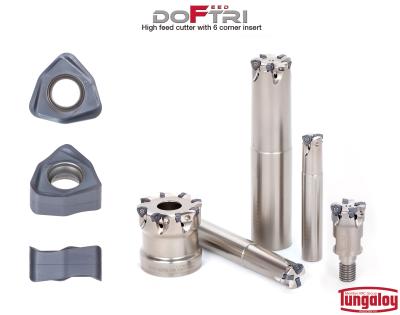
Tungaloy has unveiled DoFeedTri high-feed milling cutters that use double-sided inserts with six total cutting edges, enabling further reductions of machining costs.
Extremely economical high-feed milling cutters, DoFeedTri uses double-sided inserts with three cutting edges on each side — six total cutting edges — providing 1.5x better cost per edge than conventional inserts with four cutting edges.
DoFeedTri inserts come in a unique trigonal shape with a greater contact face that achieves secure insert retention when screw-clamped on the cutter, eliminating insert movement during machining.
Ramping down, the cutter first bottom-cuts the surface with the leading insert, then further cuts the same surface with its trailing insert. DoFeedTri inserts are designed with a long “inner” cutting edge that can bottom-cut more material than conventional milling inserts when trailing the leading insert during ramp down operations. This makes DoFeedTri a perfect tool for productive ramp down operations.
Furthermore, a reduced entry angle of the cutter eliminates chatter, improving stability during machining with long overhang tool setup. Strong cutting edges provide the insert with long tool life and security at increased machining rates.
Two insert grades are available: AH3225, the first choice for steel promising exceptionally long tool life and AH8015 that demonstrates superior performance in hardened steel and heat-resistant superalloys. Cutters are offered in the diameter range from 16 mm to 50 mm in metric sizes and from 5/8″ to 2″ in imperial sizes. With a maximum d.o.c. of 1.0 mm (.039″), the new DoFeedTri contributes to customers seeking further machining cost reductions. Total of 26 new cutters and inserts have been introduced.
Contact Details
Related Glossary Terms
- chatter
chatter
Condition of vibration involving the machine, workpiece and cutting tool. Once this condition arises, it is often self-sustaining until the problem is corrected. Chatter can be identified when lines or grooves appear at regular intervals in the workpiece. These lines or grooves are caused by the teeth of the cutter as they vibrate in and out of the workpiece and their spacing depends on the frequency of vibration.
- conventional milling ( up milling)
conventional milling ( up milling)
Cutter rotation is opposite that of the feed at the point of contact. Chips are cut at minimal thickness at the initial engagement of the cutter’s teeth with the workpiece and increase to a maximum thickness at the end of engagement. See climb milling.
- gang cutting ( milling)
gang cutting ( milling)
Machining with several cutters mounted on a single arbor, generally for simultaneous cutting.
- milling
milling
Machining operation in which metal or other material is removed by applying power to a rotating cutter. In vertical milling, the cutting tool is mounted vertically on the spindle. In horizontal milling, the cutting tool is mounted horizontally, either directly on the spindle or on an arbor. Horizontal milling is further broken down into conventional milling, where the cutter rotates opposite the direction of feed, or “up” into the workpiece; and climb milling, where the cutter rotates in the direction of feed, or “down” into the workpiece. Milling operations include plane or surface milling, endmilling, facemilling, angle milling, form milling and profiling.
- superalloys
superalloys
Tough, difficult-to-machine alloys; includes Hastelloy, Inconel and Monel. Many are nickel-base metals.

